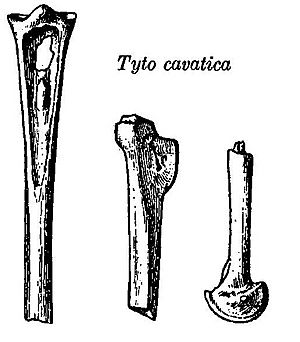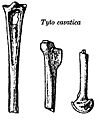Puerto Rican barn owl facts for kids
Quick facts for kids Puerto Rican barn owlTemporal range: Late Pleistocene-Holocene
|
|
|---|---|
 |
|
| Tibiotarsus and tarsometatarsus | |
| Conservation status | |
| Scientific classification | |
| Genus: |
Tyto
|
| Species: |
cavatica
|
The Puerto Rican barn owl (Tyto cavatica) was a type of barn owl that used to live on the island of Puerto Rico in the Caribbean. Sadly, this bird is now extinct, meaning it no longer exists anywhere in the world.
Sometimes, scientists thought it might have been a special kind of subspecies of the ashy-faced owl (Tyto glaucops). This means it was very similar to the ashy-faced owl but had some unique features because it lived in a different place.
Contents
What Was the Puerto Rican Barn Owl?
The Puerto Rican barn owl was a medium-sized owl. It belonged to the Tyto genus, which includes many types of barn owls found around the world. These owls are known for their heart-shaped faces and silent flight.
How Was It Discovered?
This owl was first described by a scientist named Alexander Wetmore in 1920. He studied its bones, like the tibiotarsus and tarsometatarsus, which are parts of its leg bones. These bones helped him understand what the owl looked like and how it lived.
Where Did It Live?
This special owl lived only on the island of Puerto Rico. Puerto Rico is a beautiful island located in the Caribbean Sea. It has many unique animals and plants.
Its Habitat
Like other barn owls, the Puerto Rican barn owl likely lived in open areas. These could have been grasslands, farmlands, or even forests with clearings. They would have hunted small animals in these areas.
Why Did It Become Extinct?
The Puerto Rican barn owl became extinct sometime after the Holocene period. This means it disappeared relatively recently in Earth's history.
Reasons for Extinction
Many island species, like this owl, are very sensitive to changes in their environment. When humans arrived on islands, they often brought new animals like rats, cats, or dogs. These new animals could hunt the native birds or compete for their food. Habitat loss, meaning the destruction of their natural homes, also plays a big role in extinctions.
Images for kids
See also
 In Spanish: Lechuza de Puerto Rico para niños
In Spanish: Lechuza de Puerto Rico para niños


